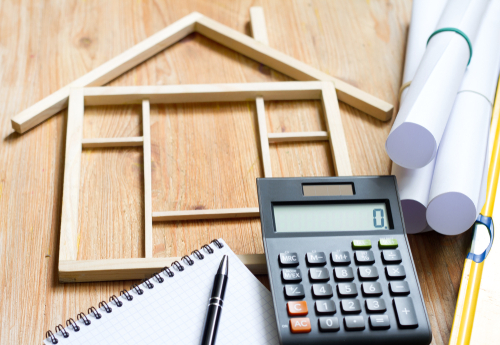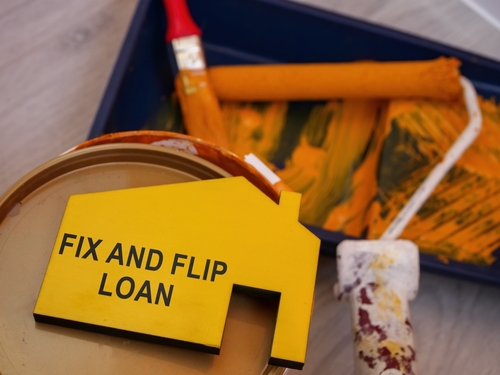Flipping Houses on a Budget: Tips for Investors
If you want to make money with real estate, you may consider investing in a fix-and-flip project. That said, while you can earn significant returns by flipping properties, planning and budgeting carefully is important to ensure a good profit. For instance, you’ll want to consider all the costs of renovations, how much time you’ll need, and how much you can sell the property for once renovations are done. If you want to learn more about flipping houses on a budget, you’re in the right place. Read along as we go over some helpful tips for investors.

Contents of This Article:
- What Is House Flipping?
- Costs to Consider While Flipping a Home
- What Is the 70% Rule?
- A Guide to Flipping Houses on a Budget
- Find a Fix-and-Flip Lender Today
What Is House Flipping?
Fix-and-flip projects are a great way for investors to profit from real estate. House flipping refers to purchasing a property intending to quickly renovate or improve it, then selling it at a higher price. Home flippers can find financing for these properties through fix-and-flip loans from hard money lenders in Baltimore. Ultimately, the goal of house flipping is to generate a profit within a relatively short amount of time, generally a few months to a year.
Home flippers add value to properties through various renovations, repairs, and cosmetic upgrades that make the house more appealing to potential buyers. As such, fix-and-flip investors must know about the local real estate market, renovation processes, and proper budgeting. Remember, there’s also a risk of unexpected expenses arising during renovations, and market conditions can change, affecting the property’s resale value.
You may have seen various TV shows that involve house flipping. However, they don’t always accurately portray the complexities and risks involved in real-world house flipping. As such, investors should thoroughly research and understand the process before diving into a fix-and-flip project. Next, we’ll review how much it costs to flip a home and how to use the 70% rule.
Costs to Consider While Flipping a Home
The average cost of flipping a home depends on several factors, like the location, extent of renovations, material costs, and property size. That said, it’s important to know what goes into the total costs, including the following:

- Purchase Price
- Closing Costs
- Taxes
- Building Materials
- Professional Labor
- Carrying Costs
- Marketing and Selling Costs
- Loan Costs
- Permits
As you can tell, there are several costs to consider–especially if you’re flipping houses on a budget. Remember, the overall goal is to profit from your investment, so it’s important to carefully plan your budget to ensure you don’t spend too much on any one area. One helpful rule to consider is the 70% rule.
What Is the 70% Rule?
The 70% rule is a general guideline used by real estate investors, usually those involved in house flipping. It can be used to help determine the maximum purchase price they should pay to achieve a profitable flip. That said, the rule suggests that an investor should not pay more than 70% of a property’s after-repair value (ARV) minus the estimated renovation costs.
Maximum Purchase Price = (ARV x 0.7) – Renovation Costs
Here’s how it works:
- Calculate the ARV– The after-repair value (ARV) is the property’s estimated market value after all the necessary renovations and improvements are made. You can find this by comparing the property to similar, recently sold properties in the same area.
- Estimate Renovation Costs– Calculate the total cost of renovations necessary to bring the property up to full market potential. Don’t forget the material and labor costs for repairs, upgrades, and cosmetic changes.
- Apply the 70% Rule– Multiply the ARV by 70% (0.7), then subtract the estimated renovation costs. The result is the maximum amount an investor should pay for the property.
Remember, the 70% rule is just a simplified guideline, not a set-in-stone rule for fix-and-flip investors. If you’re looking at flipping houses on a budget, use this rule as a helpful starting point.
A Guide to Flipping Houses on a Budget
Flipping houses on a budget requires careful planning, resourcefulness, and strategic decision-making. If you don’t know where to start, here’s a basic guide to help you get started with your investment.

Set a Realistic Budget
The first step in flipping houses on a budget is giving yourself a realistic amount to spend on the investment. Determine how much you’ll need for the property and set a budget for any renovations or repairs. This can help guide your decisions throughout the process. Remember to factor in additional costs like property taxes, insurance, and utilities during the renovation.
Do Diligent Research
When you’re on a budget, it’s important to do thorough research before choosing an investment property. You’ll want to identify target neighborhoods where property prices align with your budget and have the profit potential. So, make sure to study recent sales data and market trends to understand what types of properties are in demand and at what prices.
Look for Affordable Properties
If you want to snag an affordable deal, look for distressed properties, foreclosure auctions, short sales, or properties that have been on the market for a while. Additionally, in your negotiations, shoot for a price that allows room for renovations and profit.
Choose Renovations Wisely
Focus on cost-effective renovations and upgrades that significantly impact the property’s appearance. For instance, consider paint, flooring, fixtures, and landscaping. Additionally, focus on upgrades that provide the most value and appeal to potential buyers, like kitchens and bathrooms. However, avoid over-improving the property beyond what the market demands, as it can eat into your budget.
Put In Some Sweat Equity
Consider doing some of the work yourself if you have the necessary skills. After all, you may be able to save money by doing the painting, landscaping, and simple carpentry work. However, hiring professionals to avoid costly mistakes is advisable for more complex tasks. After all, poorly done work can deter buyers and affect the property’s value.
Use a Fix-and-Flip Loan

Consider financing options like a hard money loan or fix-and-flip loan, which are specifically designed for real estate investors. These non-conventional real estate loans usually provide short-term funding for purchasing and renovating properties. Start by researching interest rates, terms, and repayment schedules to find the best financing solution for your budget.
Plan Renovations Efficiently
Plan renovations carefully to minimize downtime and holding costs. After all, a shorter renovation period means less money spent on carrying the property. So, make sure to coordinate with contractors, suppliers, and service providers to ensure timely completion of property renovations.
Price the Property Accurately
An overpriced property can deter buyers. So, accurately price the property based on recent sales data and market trends. Additionally, market the property effectively to attract potential buyers. For instance, utilize online listing, social media, and other marketing channels. Also, consider staging the property to enhance the appeal and help buyers visualize the potential of the space. Luckily, there are several cost-effective ways to stage a home, and the effort can go a long way.
Prepare for Unexpected Costs
Have a small emergency fund to cover unforeseen expenses that may arise during renovations or the selling process. After all, you never know when something might pop up, and you don’t want to potentially eat into your profits or renovation budget. So, keep some space in your overall budget for any unexpected costs.
Find a Fix-and-Flip Lender Today
If you’re looking to invest in a fix-and-flip project, you’ll need to find the right lender to help you secure a good deal. Luckily, there are several short-term loan options for investors to choose from, including hard money loans, fix-and-flip loans, private loans, and more. Start by looking locally for a reputable lender to help you with your next real estate investment.
Maryland Hard Money Lenders has the expertise to help you succeed with your next real estate investment. Whether you’re looking to finance a rental property, fix and flip a home, or secure bridge financing, we’ve got it covered. Contact us today to learn more about our lending process, and fill out a hard money loan application here today!



